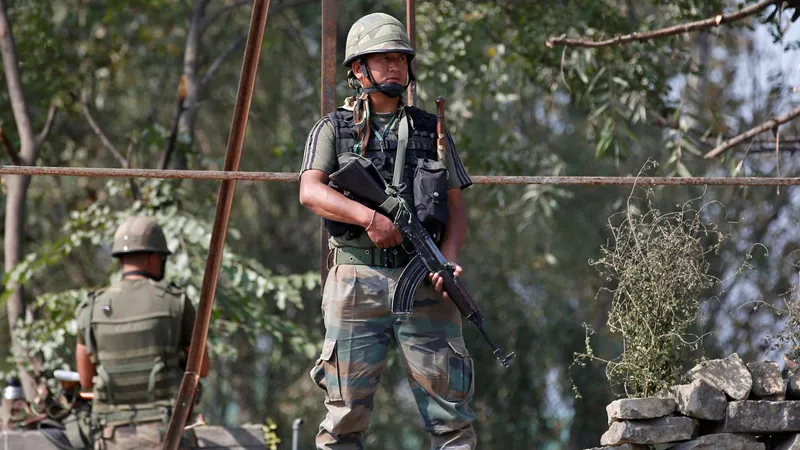There is a broad consensus after Thursday morning's daring surgical strikes on terrorist launch pads across the LoC by Indian Special Forces that we are on the cusp of a new dynamic between India and Pakistan. By shedding the posture of strategic restraint — whatever that meant — the Government of India, in one fell stroke, has called Pakistan's nuclear bluff. The primary task for planners in New Delhi will now be to assess and exploit this new-found space for extremely limited military action in meeting Pakistan's penchant for proxy warfare. As such, they will have to pay close attention to the emerging contours — and implications — of the new dynamic.
To belabour
a point made in this piece: The cross-LoC action Thursday morning, and the lack of any visible conventional response by Pakistan, shatters a widely-held view that sub-conventional, conventional and nuclear rungs in subcontinental conflicts are inexorably linked when it comes to India responding to Pakistani provocations. The argument thus far had been this: Following a terrorist attack on Indian territory, any Indian military response — as long as it involved breaching the LoC or the International Border — would force Pakistan to riposte conventionally and then, through a spiralling action-reaction logic, lead to a general war under the nuclear overhang.
Pakistan itself has done much to promote this doomsday scenario. Hence, the bluster about tactical nuclear weapons to meet a possible Indian rapid — albeit shallow — conventional thrust into territories of its interest. Indian planners for far too long had bought this logic — of an irreversible climb up the escalation ladder — which acted to self-deter India. By carefully calibrating a surgical response, India has shown that this logic is, at the most fundamental level, flawed. There is indeed space for military action (of an extremely limited nature) to retaliate against Pakistani provocations.
Rawalpindi and Islamabad's reactions have been curious. By denying that Thursday morning's surgical strikes ever took place, it seeks to de-escalate the situation. This is, by far, the most convincing sign that Pakistan's military is not an irrational entity operating according to an exceptional logic that does not match standard strategic thinking. India has also implicitly assured Pakistan that Thursday's operations have been called off, reassuring Pakistan implicitly. What we have now, in other words, is a tacit understanding between both sides that further escalation will not be beneficial to either party.
< style="color: #0069a6;">For all the talk of how South Asia is the most dangerous nuclear flashpoint on earth, both sides are playing a grown-up game.
This is not to argue, however, that there will not be any response from Pakistani side. Pakistan will do what it has done the best in the past: Leverage proxies to hit at India. In the short run, India will be well advised to prepare for terror strikes in Jammu and Kashmir, in the Indian heartland, as well as on Indian facilities and assets abroad — such as those in Afghanistan. India, in turn, will retaliate with further limited strikes as well as sub-conventionally, possibly through proxies of its own as well as through covert operations. (On the latter, one should remember that the decision to hit at terror facilities across the LoC comes on top of Prime
Minister Narendra Modi's Balochistan gambit announced last month from the ramparts of the Red Fort.)
< style="color: #0069a6;">In the short run, India will be well advised to prepare for terror strikes in Jammu and Kashmir, in the Indian heartland, as well as on Indian facilities and assets abroad — such as those in Afghanistan.
Therefore, the new dynamic would be an oscillatory pattern involving the sub-conventional and the uncoventional (covert special operations support for proxies) or the semi-conventional (overt special operations alone) rungs. There is no escalation ladder for both countries to climb, New Delhi and Rawalpindi would quickly realise, if they haven't already. Instead, they will chase each other's tails — which works in New Delhi's calculations. Instead of a grand conflagration leading to a decisive war — which cockles the hearts of many in Pakistan and also, it must be said, in India, we are looking at an era where both sides will play tic-tac-toe with special operators, proxies, and border action teams.
The other facet of the new dynamic is the irrelevance of the LoC in any Indian decision to take the fight to Pakistan. The American game theorist, military planner and Nobel Laureate Thomas Schelling — in his classic study on bargaining, strategy, and conflict — invented the notion of a 'focal point': A mental, geographical and/or psychological demarcation between adversaries locked in a conflict which neither side would breach. Focal points arise due to many extra-rational reasons such as history or cartography, and there is a tacit understanding between adversaries that breach of focal points will inexorably lead to instability. The Kargil war of 1999 and Thursday morning's surgical strikes have now decisively proved that the LoC is not a focal point for India and Pakistan.
This will eventually become extremely important in determining the long-run political solution to the Kashmir imbroglio.
This commentary originally appeared in FirstPost.
The views expressed above belong to the author(s). ORF research and analyses now available on Telegram! Click here to access our curated content — blogs, longforms and interviews.




 PREV
PREV


